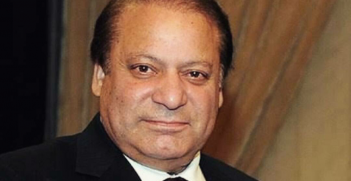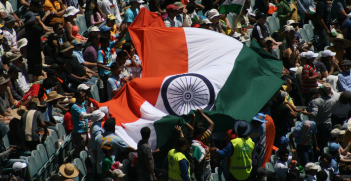The Real "Made in India" Product: The Politics of Polarisation and Pakistan-Bashing

India’s masculine prime minister formulates policy based on polarisation and Pakistan-bashing. The result is that protecting cows, constructing temples and showing Pakistan who is the bigger man are the real “Made in India” products.
India’s “divider in chief” — and most polarising figure — is Prime Minister and Leader of the Bhartiya Janta Party (BJP) Narendra Modi. For him, “polarisation” and “Pakistan” are not just terms but central guiding themes to policy, and the most effective bandage for hiding the scars of unfulfilled promises and of policies that did not kick off.
Not only does this work to define a clear target audience from which to garner votes but it also gives the image-loving — rather than policy loving — country fodder to elect a masculine protector of the nation and messiah to all of their problems.
With the recent elections giving a stronger mandate to the prime minister than in 2014, India is today a nation far away from its soul of “unity in diversity” and is facing a “saffronisation” — Hindu right-wing — rebranding that can be fatal if ignored. The reason that the approach seems to be working is hidden in India’s troubled past, in the tendency of its citizens to prioritise the nationalistic identity over development and in its technology-enriched new-age population that sees India differently to its past.
Rather than focusing on needed economic reforms, an unemployment crisis and slower than ideal growth, the campaign was made into a “us” versus “them” battle. The importance of “Hindu Rashtra” — a Hindu India — that now “answers back” to its challengers is different from traditional concepts of equality and non-aggresive diplomacy. An increasing number of young minds are aligning with this.
A deeper analysis into the election trends sees the BJP holding strong in its “Hindi heartland” of North and Central India and making inroads in the eastern parts such as Bengal. These are some of the most polarised and anti-Pakistan parts of the country, whose population has faced the sorrows of partition and has “constructed” the neighbour as an enemy not only to the country but also to their civilisation.
A macho and retaliating strong leader is what appeals to these people because it gives them the feeling of superiority that in their minds “Ram deserves over Allah.” Hindu creations are seen as superior to those of Muslims, forgetting that traditions from the sarees of Banaras to the delicacies of Lucknow all have arisen out of the comingling and diversity of both these sects.
In 2014, with the backdrop of a slowing economy and a corrupt Congress, Prime Minister Modi rose to power with his revolutionary economic agenda and his transformative persona, but today he has lead India towards greater challenges of rising unemployment, slower than expected growth due to rash domestic policies such as demonetisation and GST and growing distress among farmers. The prime minister has answered these criticisms with his claims of forged data and notions that India now pays back “with interest.”
India’s unemployment issue is far worse than most people understand. It is not only a lack of jobs but also the constant issue of underemployment and lack of skills development. The biggest threat has come from government mishandling of data and the questionable credibility of the measuring mechanisms. India has grown but needs to grow at a much faster rate to keep up with its population demands.
The government brought in “Made in India,” “Skill India” and other incentives to make India easy to do business with and to make the country into a manufacturing hub. Instead, the country is as divided as it has been since independence and the fringe is now mainstreamed. Protecting cows, constructing temples and showing Pakistan who is the bigger man are the real things these days that are “Made in India.”
The Pakistan security dilemma continues to enjoy great success because of the current Kashmir scenario as well especially after Uri Surgical Strikes in 2016 and the Pulwama Attack 2019. The BJP strategically withdrew support from the PDP-led state government by labeling them as pro-Pakistan in a larger bid to gain future power in the region. Modi is an election juggernaut which just wants to tremble winning elections and that’s where his real Made in India products help him out.
The current scenario of India’s economic woes has given a much dangerous result in the form of a societal divide legitimised by the government. Long before Donald Trump won in 2016, Modi in 2014 had started the populist bandwagon portraying himself as an economic saviour. But what transpired was a social fracture that will take years to heal. In contrast, Pakistan sees Modi as a chance for talks to resume.
The logic is that two right-wing leaning leaders can sort the long-standing Kashmir issue. But this hope is false because Modi sees himself not as a peacemaker but as “revenge-taker.” He is a real-world “Thanos” wanting to run the universe according to his ideology and not the “Tony Stark” that Pakistan expects him to be. What is crucial is that Indians have afforded him another chance to do something where it will be interesting to see whether he addresses the challenges ahead of him like real economic growth, climate change and sustainable industrial acceleration.
It is true that it has been a toxic environment leading to his comeback, but the greater reality for India is how he has redefined the Indian political landscape. It’s now more about the man rather than particular policies and ideologies. This has changed the character of the world’s largest democracy and by extension is also a threat in the global system.
But it is important to remember that India’s real nationalist symbol and real home-made product — it’s national flag — is not only “Saffron” but has White and Green showing the nation’s real soul and identity that cannot be lost. The decision is now in the hands of Indians to choose what their real “Made in India” product is.
Pranav Arora is completing a Master in International Relations at Monash University.
This article is published under a Creative Commons Licence and may be republished with attribution.





